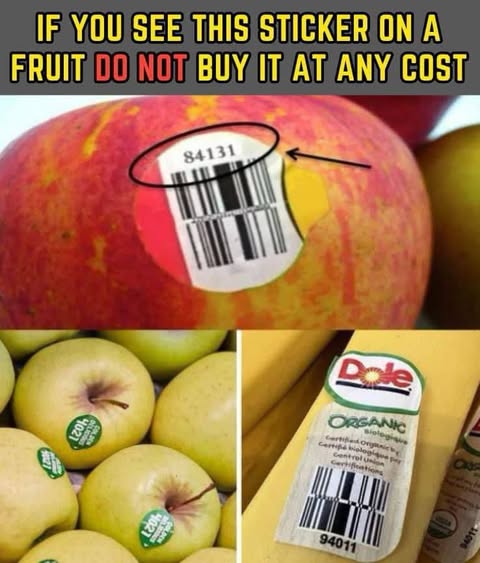When we shop for groceries, we often focus on the brand, price, and expiration dates, but rarely do we consider the numbers on the labels of fruits and vegetables. These numbers, though small, carry useful information about the food we purchase. While many of us might overlook them, understanding what these digits represent can offer insight into how the product was grown and processed.

The numbers you find on fruit stickers are more than just price codes; they indicate the method of production used for the produce. One important detail is the first digit of the code, which provides valuable information.
Organic Produce:
If the sticker starts with the number 9, it indicates that the fruit or vegetable was grown organically. Organic farming avoids synthetic chemicals, using natural methods like crop rotation and biological pest control to grow the produce. Organic products are often seen as more environmentally friendly and healthier, though the debate about their efficacy and price continues.
Genetically Modified Produce:
On the other hand, if the label begins with the number 8, it signifies that the fruit has been genetically modified (GMO). Genetically modified foods are developed to enhance certain traits such as pest resistance, herbicide tolerance, or improved nutritional value. While GMO crops are widely used and have been studied for safety, concerns about their long-term health effects persist. Common genetically modified fruits include papayas, apples, and grapes. Research is ongoing to understand the potential impact on health and the environment.
Conventional Farming:
If the label features a 4-digit code starting with the number 3 or 4, the produce has been grown conventionally. This typically means the fruit or vegetable was cultivated using synthetic fertilizers and pesticides, which are common in conventional farming methods. These practices are under federal regulation, ensuring that the food is safe for consumption. However, there is ongoing debate about the environmental and health effects of conventional farming compared to organic practices.
Dr. Tamika D. Sims, a food technology expert, states that both organic and conventional farming methods are regulated, and consumers should focus on maintaining a balanced diet instead of being overly concerned with the numbers on their food. In her view, it’s more important to choose a variety of nutritious foods than to stress about how they were grown.
PLU Codes and Their Importance:
The number of digits on the sticker matters as well. Four-digit codes generally indicate conventionally grown produce, while five-digit codes provide more specific information about how the food was grown—whether it was organic or genetically modified. For instance, a five-digit number starting with 9 signals an organic item, while one starting with 8 indicates a GMO product. If a fruit has a sticker with more than five digits, it’s likely not part of the international standard system for labeling.
Although the PLU (Price Look-Up) system is optional, it’s used by many supermarkets to categorize produce and streamline the checkout process. This system helps identify the origin and type of produce more quickly, making shopping more efficient for consumers and retailers alike.
The International Federation for Produce Standards (IFPS) introduced this system in the 1990s to maintain high quality across the global produce market. The IFPS has created more than 1,400 codes, each corresponding to a specific type of fruit or vegetable, with a goal of improving efficiency and consistency in the food supply chain.
Conclusion:
Understanding the numbers on fruit stickers can give us better insight into the food we eat, from its growing method to its potential impact on health and the environment. While many shoppers may not pay much attention to these codes, being mindful of them can help us make more informed decisions at the grocery store, ensuring we choose produce that aligns with our values, whether it’s organic, conventional, or genetically modified. Additionally, this knowledge can speed up the checkout process by allowing us to quickly identify the right item using its PLU code. By becoming more aware of these details, we can be more conscious of the choices we make for our health and well-being.